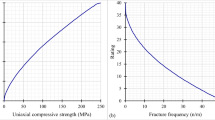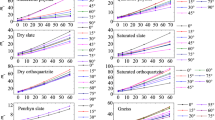Abstract
The engineering behavior of rock masses is strongly dependent on anisotropy, which is present at different scales, from the microscale in the intact rock due to the alignment of rock crystals (inherent anisotropy) to the macroscale in rock masses with anisotropic rock structure, characterized by distinct bedding or schistosity planes. This paper presents a new rock mass classification system, Anisotropic Rock Mass Rating (ARMR), specifically developed for the classification of anisotropic rock masses. ARMR considers the following rating parameters: (a) anisotropy strength index, RC; (b) uniaxial compressive strength of intact rock; (c) degree of structure anisotropy; (d) corrected rock quality designation (RQD); (e) condition of anisotropy surfaces; and (f) groundwater conditions. Its use is illustrated and explained by application to specific case studies in anisotropic rock masses, and the advantages and limitations of the classification system are outlined. The strength of anisotropic rock masses is determined using the modified Hoek–Brown criterion (Saroglou and Tsiambaos, Int J Rock Mech Mining Sci 45:223–234, 2008), which is extended to rock masses with the use of ARMR.










Similar content being viewed by others
References
Aydan Ö, Ulusay R, Tokashiki N (2014) A new rock mass quality rating system: rock mass quality rating (RMQR) and its application to the estimation of geomechanical characteristics of rock masses. Rock Mech Rock Eng 47(4):1255–1276
Bar N, Johnson TM, Weekes G (2016) Using directional shear stress models to predict slope stability in highly anisotropic rock masses. In: Ulusay R, Aydan O, Gerçek H, Hindistan MA, Tuncay E (eds) Proceedings of the 2016 ISRM international symposium. Rock mechanics and rock engineering: from the past to the future, Cappadocia, Turkey, August 2016, pp 595–600
Barton N, Quadros E (2015) Anisotropy is everywhere, to see, to measure, and to model. Rock Mech Rock Eng 48:1323–1339. https://doi.org/10.1007/s00603-014-0632-7
Barton N, Lien R, Lunde J (1974) Engineering classification of rock masses for the design of tunnel support. Rock Mech 6(4):189–239
Bewick RP, Kaiser PK (2009) Influence of rock mass anisotropy on tunnel stability. In: Diederichs M, Grasselli G (eds) ROCKENG09: proceedings of the 3rd CANUS rock mechanics symposium, Toronto, Canada, May 2009
Bieniawski ZT (1973) Engineering classification of jointed rock masses. Trans S Afr Inst Civ Engrs 15:335–344
Bieniawski ZT (1989) Engineering rock mass classifications. Wiley, New York
Bonini M, Barla G (2012) The Saint Martin La Porte access adit (Lyon–Turin Base tunnel) revisited. Tunn Undergr Space Technol 30:38–54
Cai M, Kaiser P (2006) Visualization of rock mass classification systems. Geotech Geol Eng 24:1089–1102
Chen YF, Wei K, Liu W, Hu SH, Hu R, Zhou CB (2016) Experimental characterization and micromechanical modelling of anisotropic slates. Rock Mech Rock Eng 49:3541–3557. https://doi.org/10.1007/s00603-016-1009-x
Donath FA (1961) Experimental study of shear failure in anisotropic rocks. Geol Soc Am Bull 72:985–990
Hoek E, Brown ET (1997) Practical estimates of rock mass strength. Int J Rock Mech Min Sci 34(8):1165–1186
Hoek E, Karzulovic A (2000) Rock mass properties for surface mines. In: Hustralid WA, McCarter MK, van Zyl DJA (eds) Slope stability in surface mining. Society for Mining, Metallurgical and Exploration (SME), Littleton, Colorado, pp 59–70
Hoek E, Kaiser PK, Bawden WF (1995) Support of underground excavations in hard rock. AA Balkema, Rotterdam
Hoek E, Marinos P, Benissi M (1998) Applicability of the geological strength index (GSI) classification for very weak and sheared rock masses. The case of the Athens Schist Formation. Bull Eng Geol Environ 57(2):151–160
Hoek E, Carranza-Torres C, Corkum B (2002) The Hoek–Brown failure criterion—2002 edition. In: Proceedings of the 5th North American rock mechanics symposium and 17th Tunnelling Association of Canada Conference: NARMS-TAC, Toronto, Canada, pp 267–271
Hoek E, Carter TG, Diederichs MS (2013) Quantification of the Geological Strength Index chart. In: Proceedings of the 47th US rock mechanics/geomechanics symposium, San Francisco, California, June 2013, paper ARMA 13-672
International Society for Rock Mechanics (ISRM) (2007) The complete ISRM suggested methods for rock characterization, testing and monitoring: 1974–2006. In: Ulusay R, Hudson JA (eds) Suggested methods prepared by the ISRM commission on testing methods. Compilation arranged by the ISRM Turkish National Group, Ankara
Ismael MA, Imam HF, El-Shayeb Y (2014) A simplified approach to directly consider intact rock anisotropy in Hoek–Brown failure criterion. J Rock Mech Geotech Eng 6(5):486–492
Jaeger JC (1960) Shear failure of anisotropic rocks. Geol Mag 97:65–72
Jakubec J, Laubscher DH (2000) The MRMR rock mass rating classification system in mining practice. In: Proceedings of MassMin 2000, Brisbane, Australia, October/November 2000, pp 413–421
Laubscher DH (1990) A geomechanics classification system for the rating of rock mass in mine design. J S Afr Inst Min Metall 90:257–273
Lowson AR, Bieniawski ZT (2013) Critical assessment of RMR-based tunnel design practices: a practical engineer’s approach. In: Proceedings of the rapid excavation & tunneling conference (RETC 2013) Washington, DC, June 2013.. Society of Mining Engineers, pp 180–198
Marinos P, Hoek E (2000) GSI—a geologically friendly tool for rock mass strength estimation. In: Proceedings of the GeoEng2000 conference, Melbourne, Australia, November 2000
Marinos V, Marinos P, Hoek E (2005) The geological strength index: applications and limitations. Bull Eng Geol Environ 64(1):55–65
Marinos PG, Marinos V, Hoek E (2007) The Geological Strength Index (GSI): a characterization tool for assessing engineering properties for rock masses. In: Proceedings of the international workshop on rock mass classification in underground mining. DHHS (NIOSH) publication no. 2007-128
Martin CD, Kaiser PK, McCreath DR (1999) Hoek–Brown parameters for predicting the depth of brittle failure around tunnels. Can Geotech J 36:136–151
Martin CD, Giger S, Lanyon GW (2016) Behaviour of weak shales in underground environments. Rock Mech Rock Eng 49:673–687
National Standards Compilation Group of People’s Republic of China (1994) GB 50218-94. Standard for engineering classification of rock masses. China Planning Press, Beijing, China, pp 1–22 (in Chinese)
Osgoui RR, Ulusay R, Unal E (2010) An assistant tool for the Geological Strength Index to better characterize poor and very poor rock masses. Int J Rock Mech Min Sci 47:690–697
Palmstrøm A (1982) The volumetric joint count—a useful and simple measure of the degree of jointing. In: Proceedings of the 4th international congress of the International Association of Engineering Geology (IAEG), New Delhi, India, December 1982, pp V.221–V.228
Palmstrøm A (1996) Characterizing rock masses by the RMi for use in practical rock engineering. Tunnel Undergr Space Technol 11(2):175–186 (part 1); 11(3):287–303 (part 2)
Palmstrom A, Broch E (2006) Use and misuse of rock mass classification systems with particular reference to the Q-system. Tunn Undergr Space Technol 21:575–593
Papavasiliou S, Nomikos PP, Sofianos AI (2010) Tunnel overstressing due to the anisotropic rock structure. In: Proceedings of the 6th Asian rock mechanics symposium, New Delhi, India, October 2010, paper no. ARMS6-2010-081
Ramamurthy T (1993) Strength and modulus responses of anisotropic rocks. In: Hudson JA (ed) Comprehensive rock engineering, vol 1. Pergamon Press, Oxford, pp 313–329
Rettighieri M, Triclot J, Mathieu E, Barla G, Panet M (2008) Difficulties associated with high convergences during excavation of the Saint Martin La Porte access adit. In: Building underground for the future: proceedings of the AFTES international congress, Monaco, Monte Carlo, October 2008. AFTES, Limonest, France, pp 395–403
Saroglou H (2007) Geological parameters affecting the geotechnical properties of intact rock. The effect of anisotropy. PhD thesis, National Technical University of Athens, 480 pp
Saroglou H (2013) Engineering behaviour of anisotropic and heterogeneous layered rocks. In: Proceedings of the IAEG conference “Global view of engineering geology and the environment”, Beijing, China, September 2013, pp 721–731
Saroglou H, Tsiambaos G (2007) Classification of anisotropic rocks. In: Proceedings of the 11th International congress of rock mechanics, Lisbon, Portugal, July 2007, vol 1, pp 191–196
Saroglou H, Tsiambaos G (2008) A modified Hoek–Brown failure criterion for anisotropic intact rock. Int J Rock Mech Min Sci 45:223–234
Schubert W, Mendez JMD (2017) Influence of foliation orientation on tunnel behavior. Proc Eng 191:880–885
Singh B, Göel RK (1999) Rock mass classification. A practical approach in civil engineering. Elsevier, the Netherlands
Sonmez H, Ulusay R (1999) Modifications to the geological strength index (GSI) and their applicability to stability of slopes. Int J Rock Mech Min Sci 36:743–760
Truzman EIM (2009) Metamorphic rock mass characterization using the Geological Strength Index (GSI). In: Paper presented at the 43rd US rock mechanics symposium and 4th US–Canada rock mechanics symposium, Asheville, North Carolina, June/July 2009, 2009/1/1
Vutukuri VS, Hossaini SMF, Foroughi MH (1995) A study of the effect of roughness and inclination of weakness planes on the strength properties of rock and coal. In: Proceedings of the 2nd international conference on the mechanics of jointed and faulted rock, Vienna, Austria, April 1995. Balkema, pp 151–155
Wickham, G.E., Tiedemann, H. R. and Skinner, E. H. (1972). Support determination based on geologic predictions, In: Lane, K.S.a.G., L. A., ed., North American Rapid Excavation and Tunneling Conference: Chicago, New York: Society of Mining Engineers of the American Institute of Mining, Metallurgical and Petroleum Engineers, p. 43–64
Acknowledgements
Dr. Saroglou acknowledges Prof. Qi and the Institute of Geology and Geophysics at the Chinese Academy of Sciences, where he was invited as a Visiting Professor under the President’s International Fellowship Initiative (PIFI). The assistance of Mr. N. Bar, Civil Engineer at Gecko Geotechnics Pty Ltd. and Mr. A. Maldonado, MPh Eng at UWA, Mining School, Mr. A. Stavrou, Engineering Geologist and Mr. S. Pollak, Civil Engineer from Arup Group are acknowledged for providing data.
Author information
Authors and Affiliations
Corresponding author
Rights and permissions
About this article
Cite this article
Saroglou, C., Qi, S., Guo, S. et al. ARMR, a new classification system for the rating of anisotropic rock masses. Bull Eng Geol Environ 78, 3611–3626 (2019). https://doi.org/10.1007/s10064-018-1369-4
Received:
Accepted:
Published:
Issue Date:
DOI: https://doi.org/10.1007/s10064-018-1369-4




